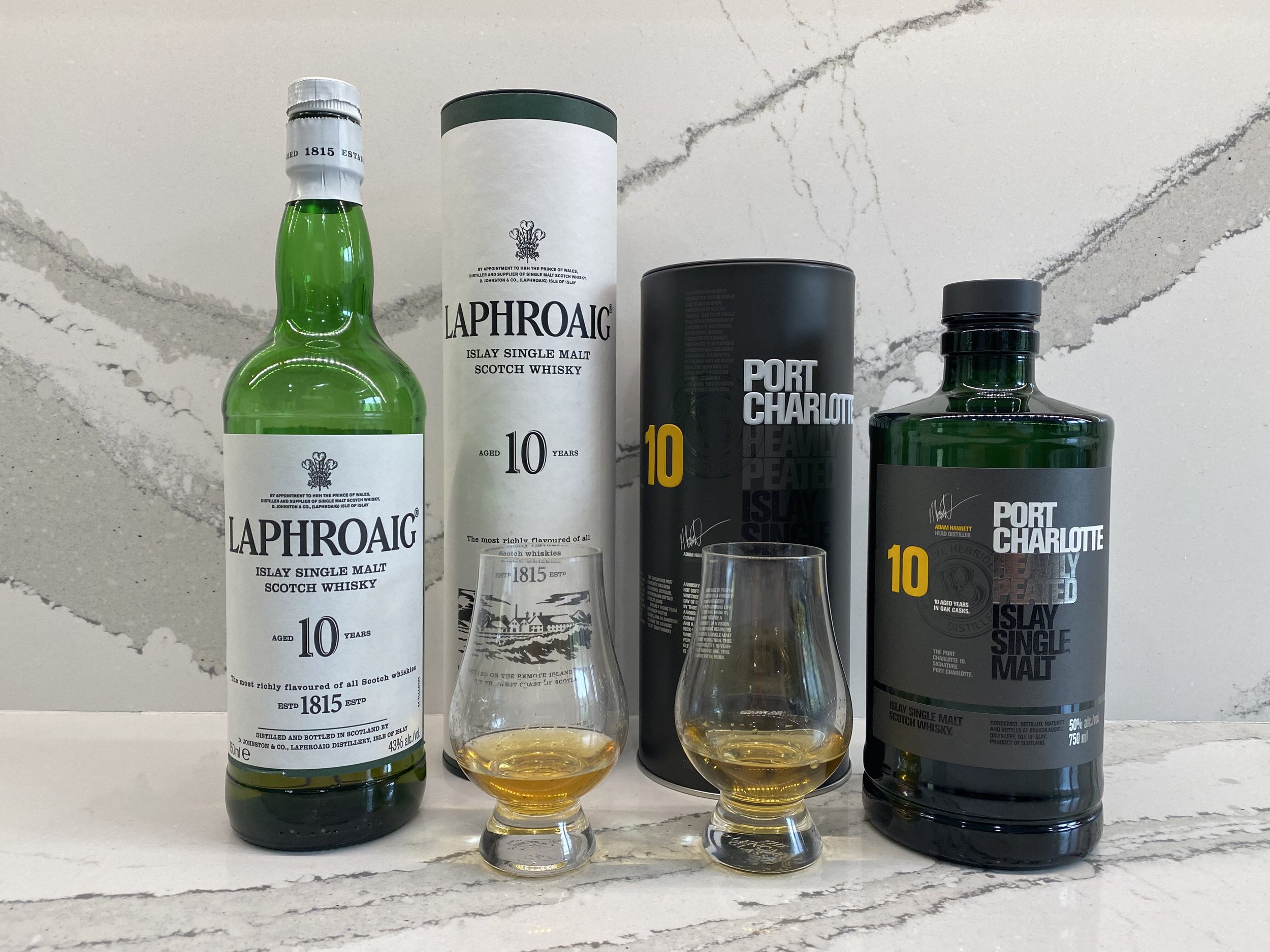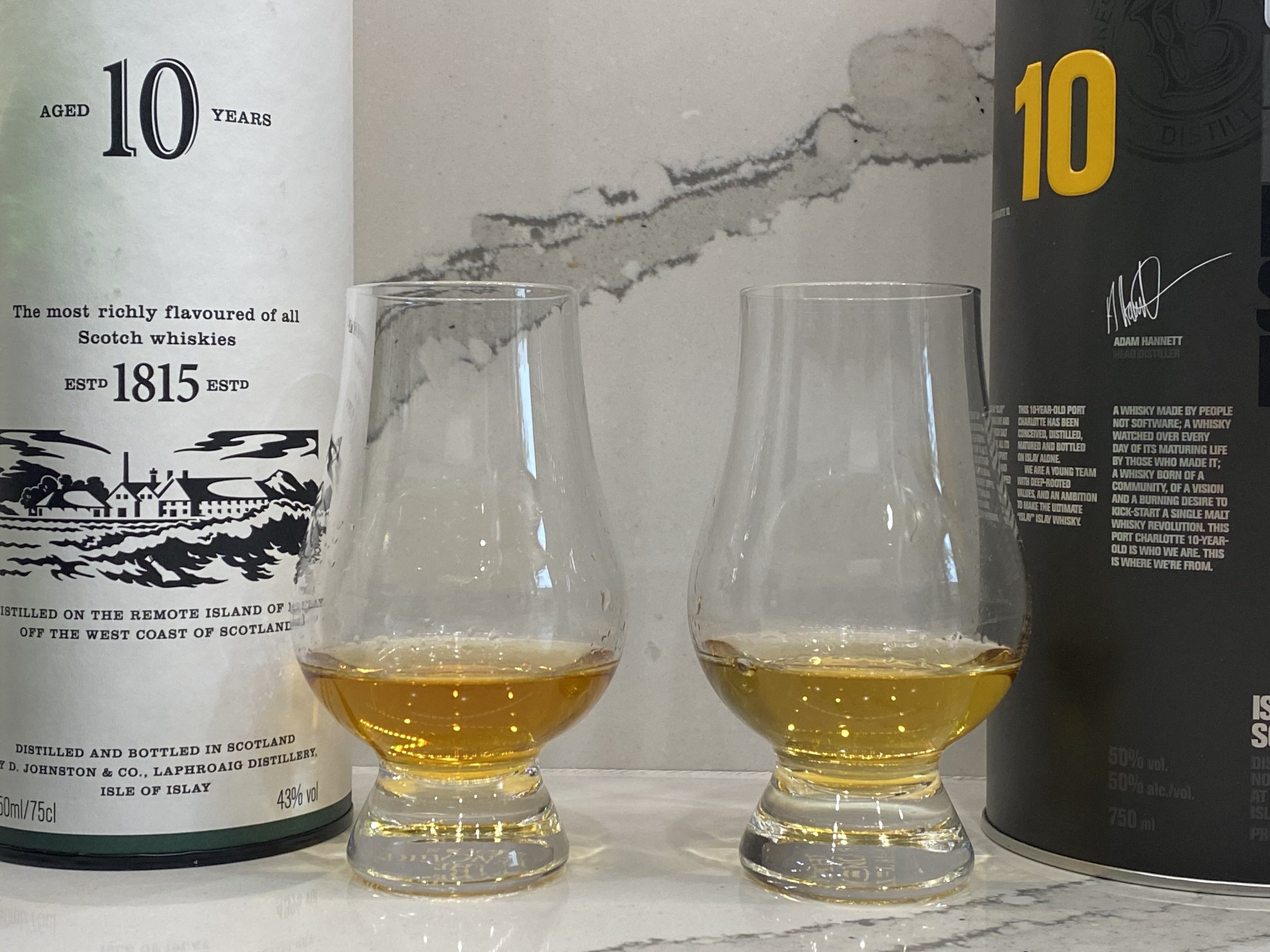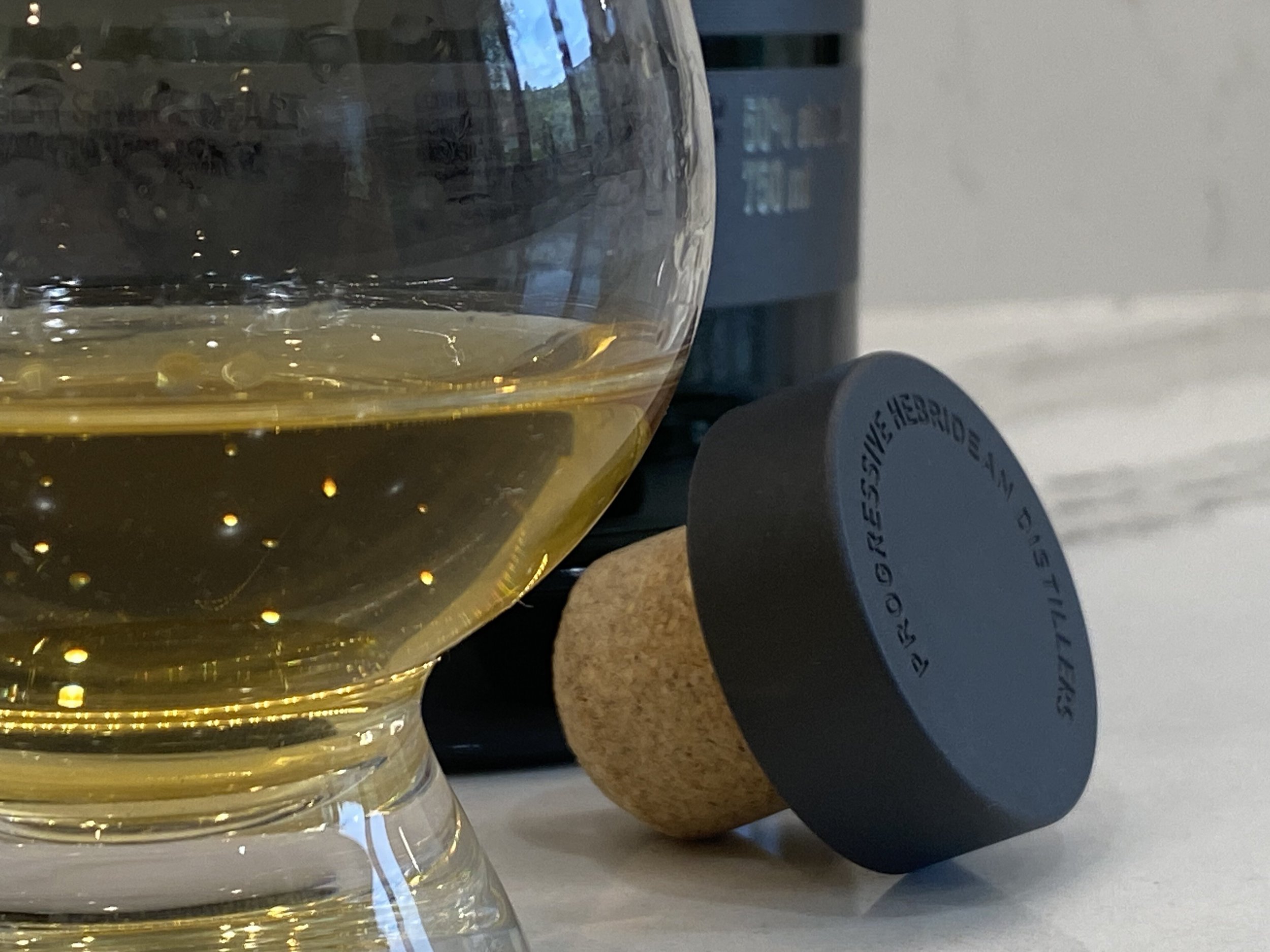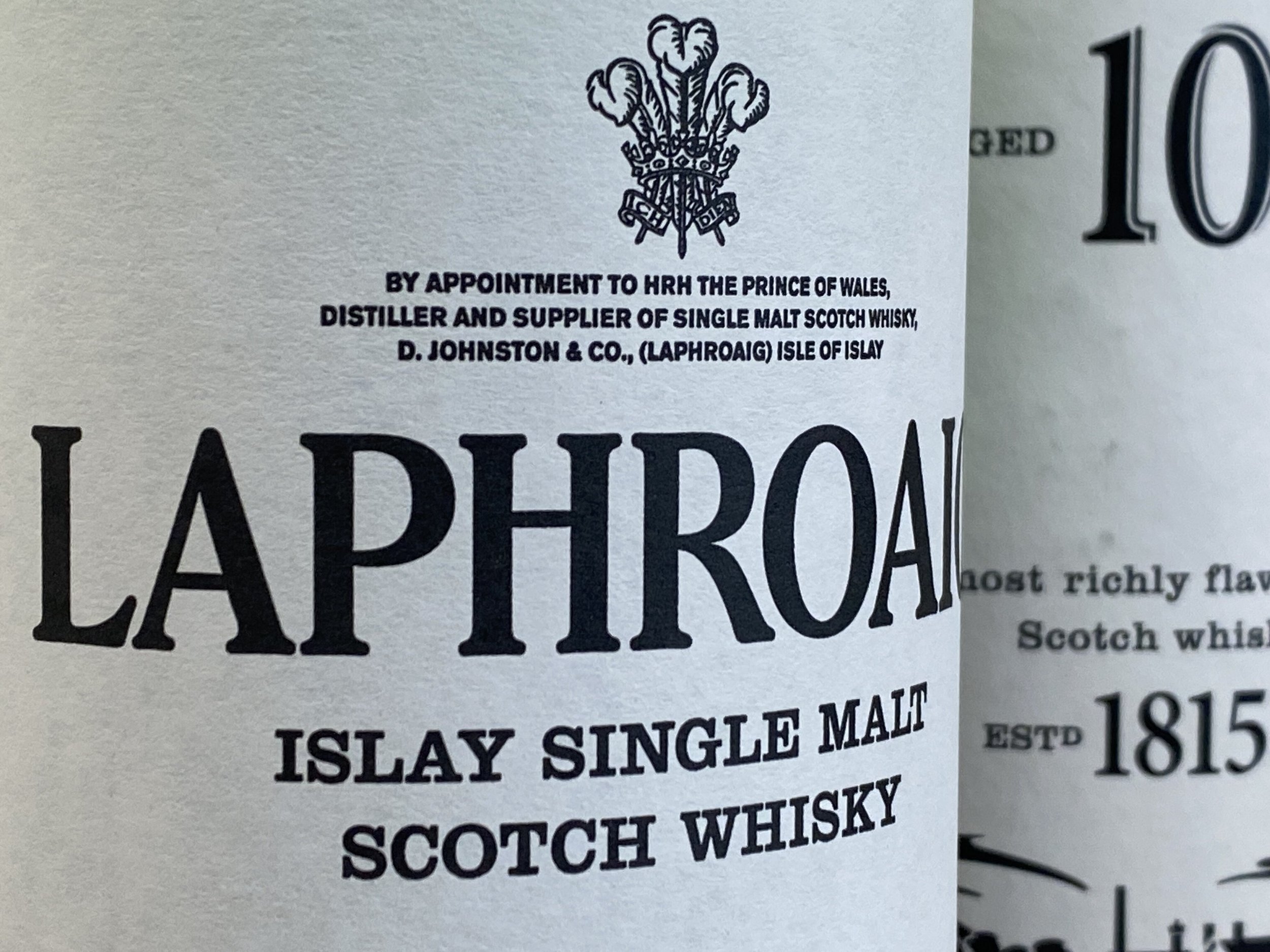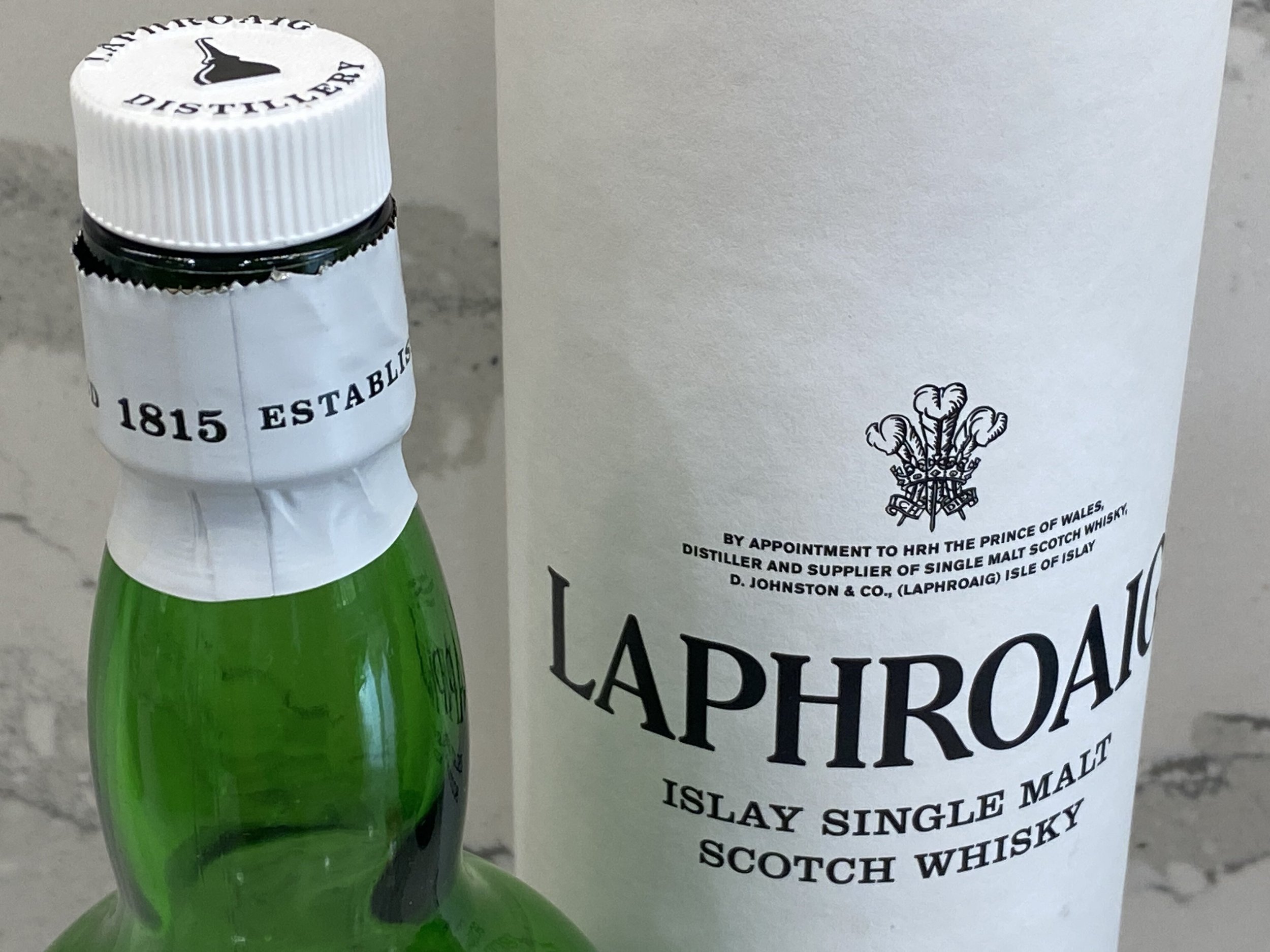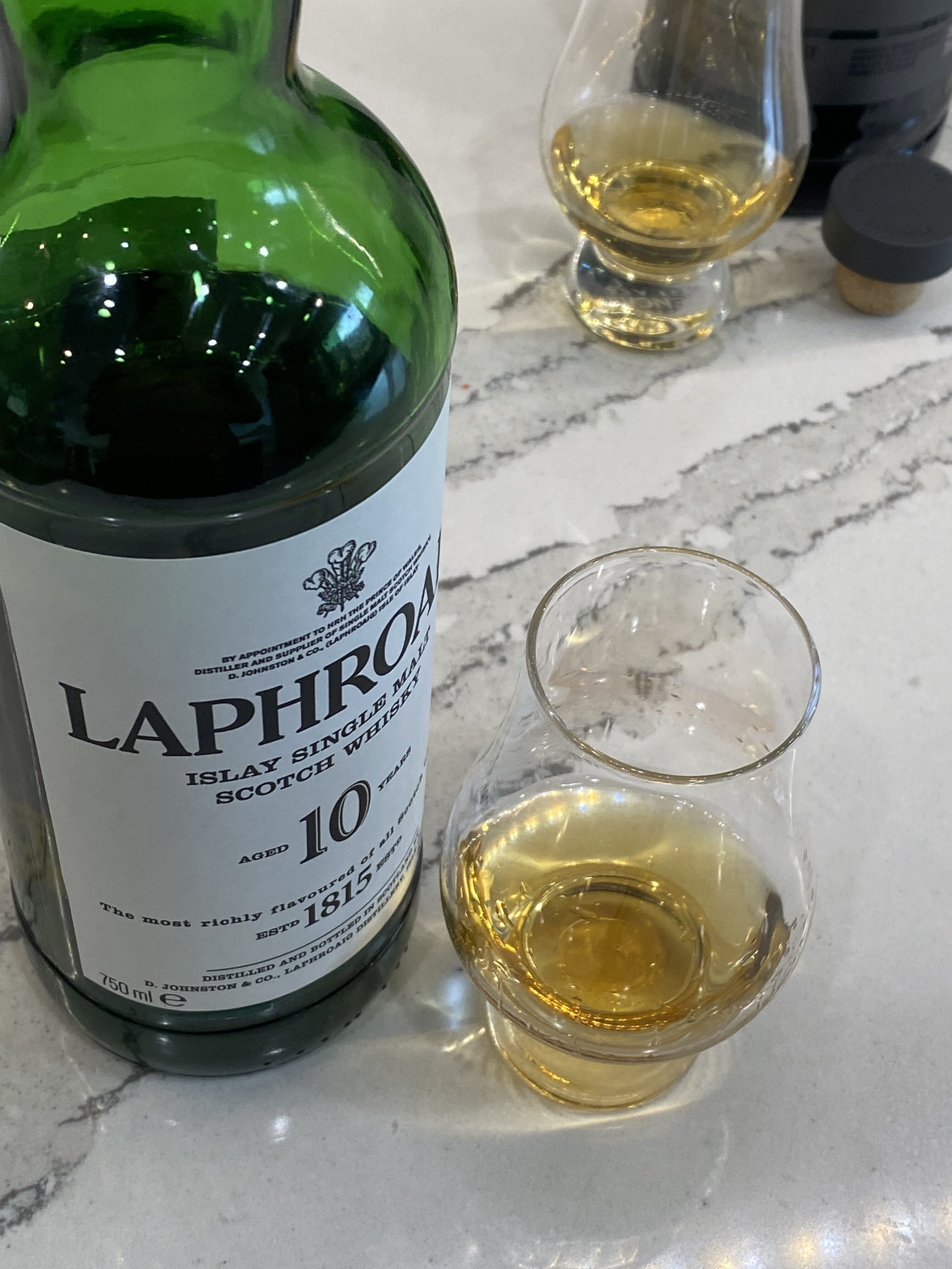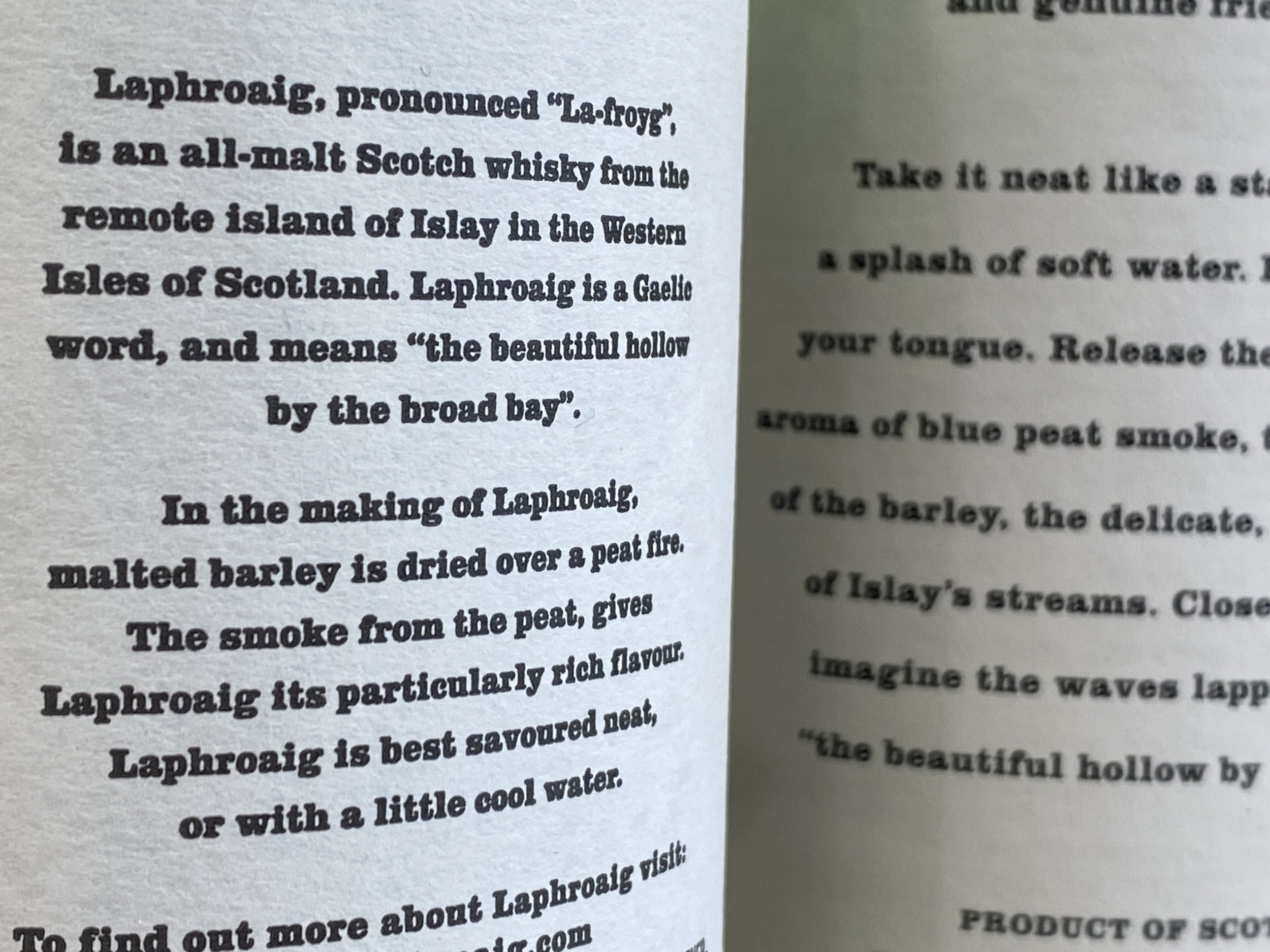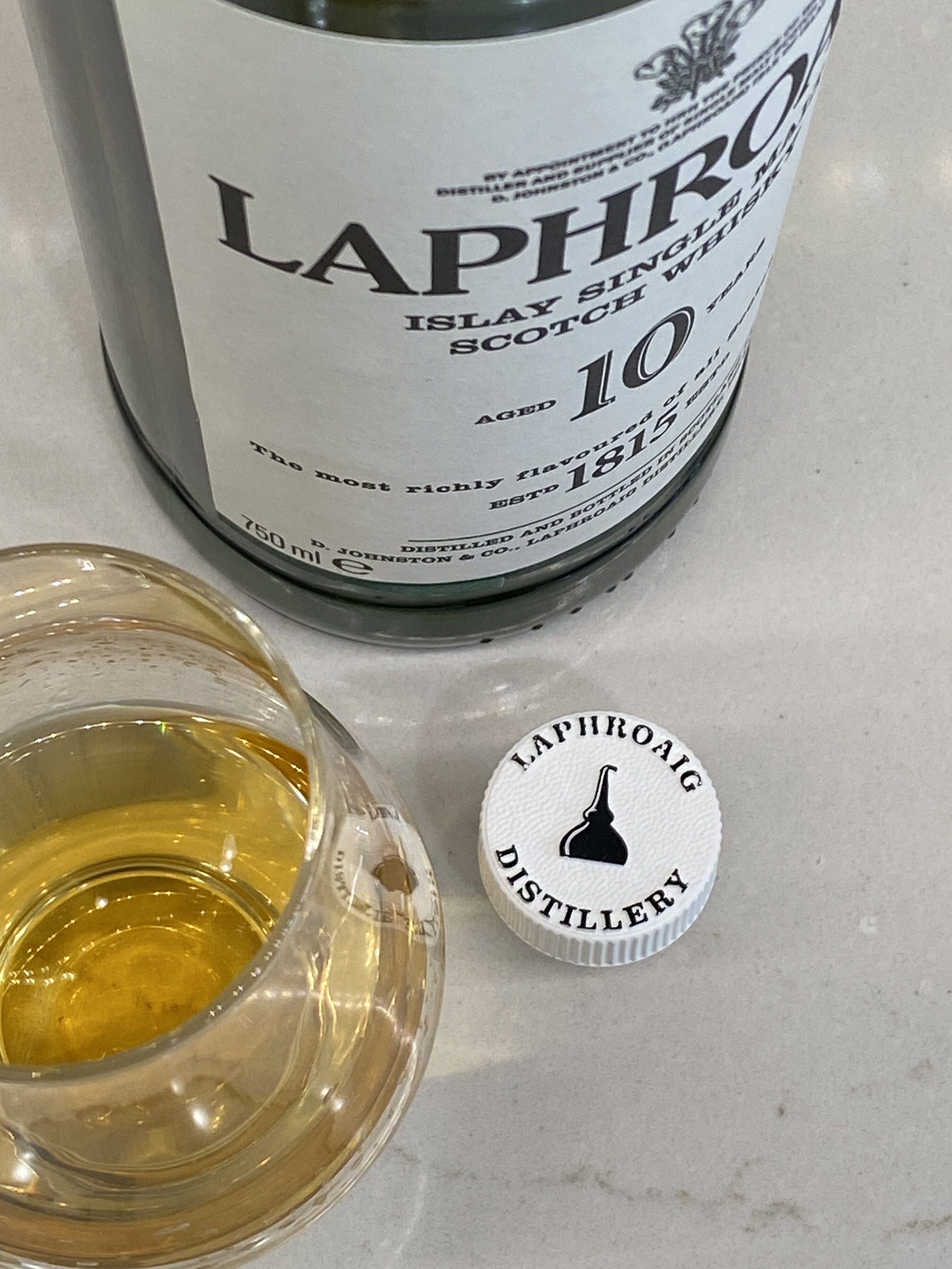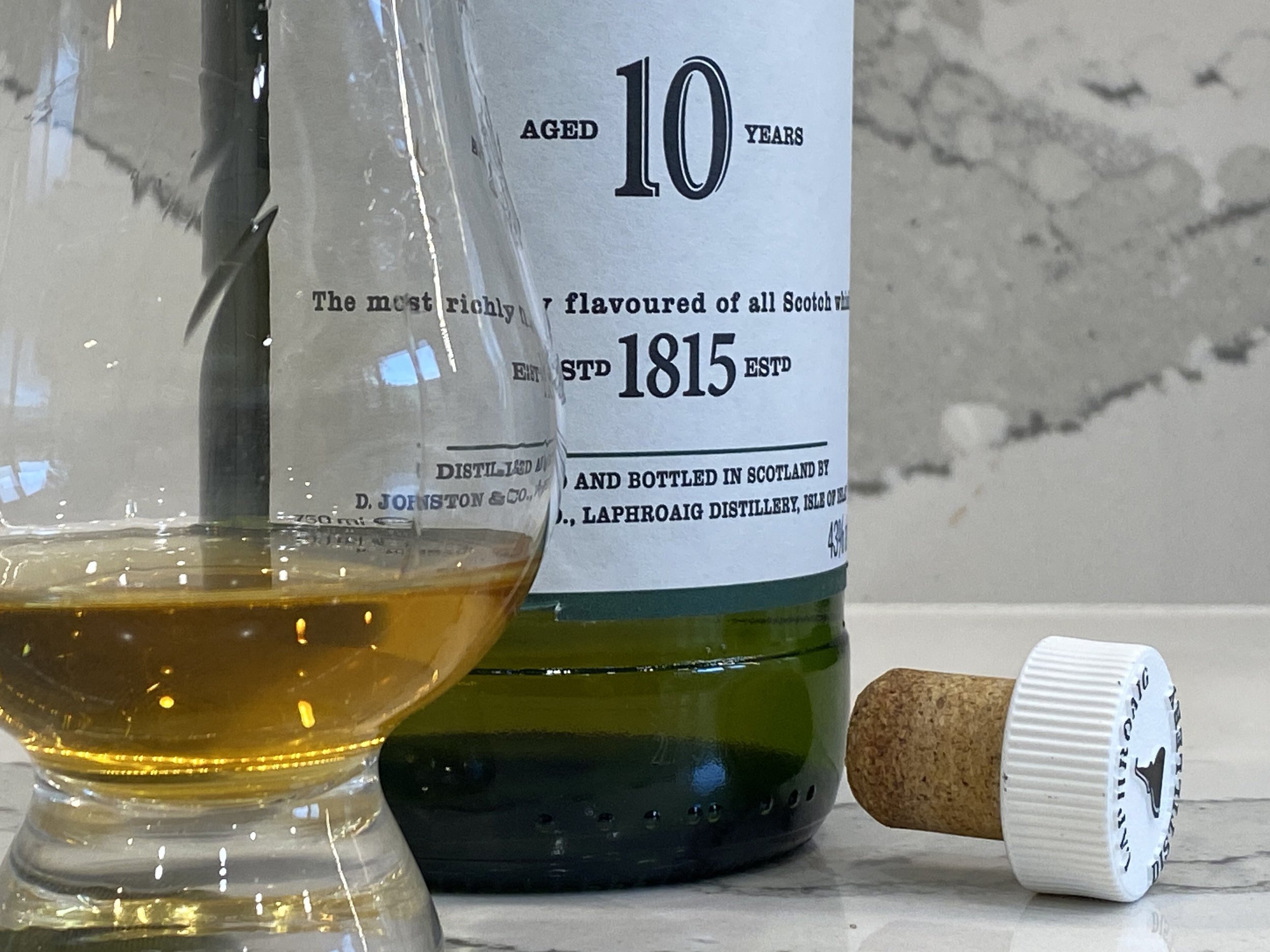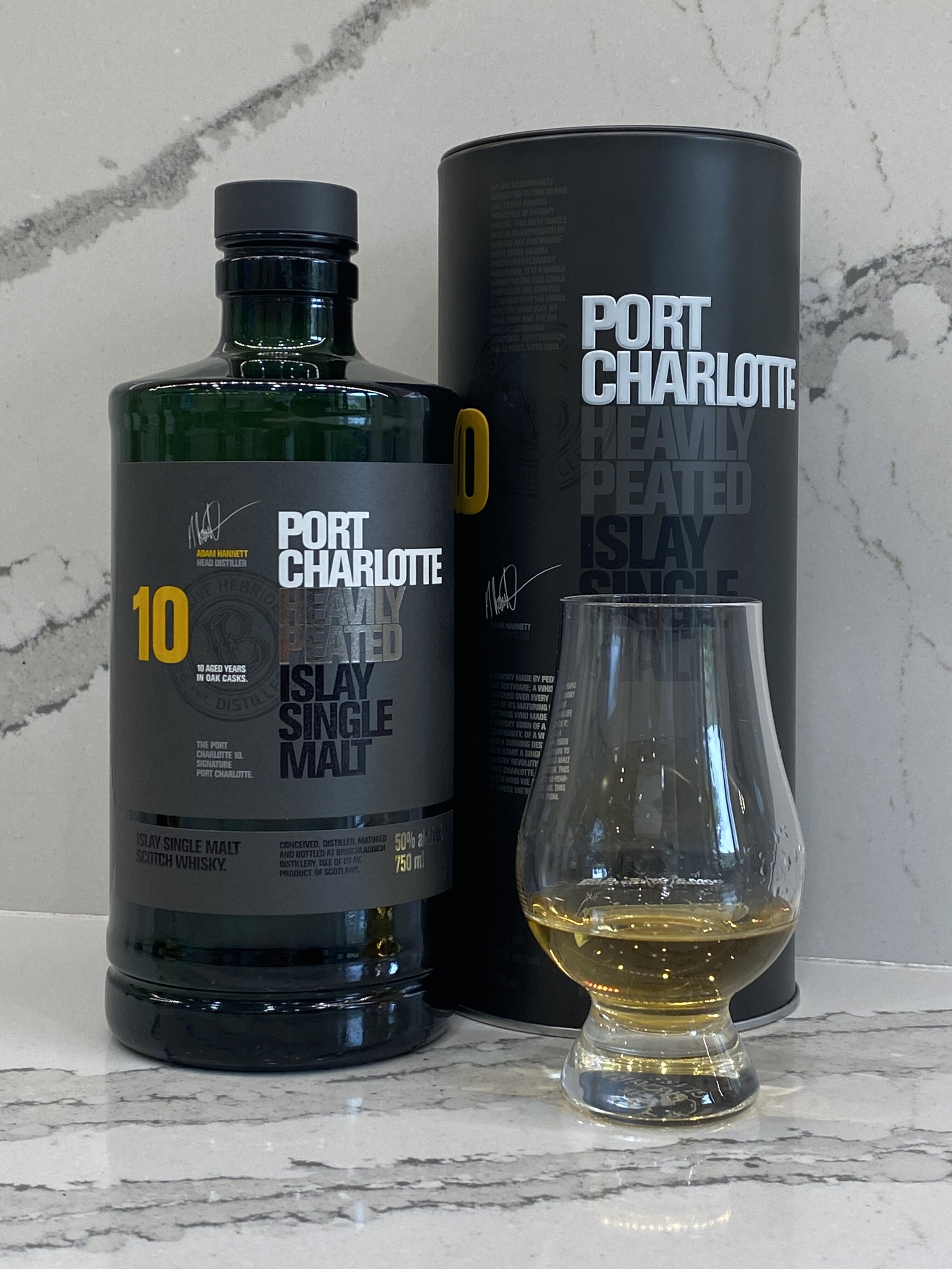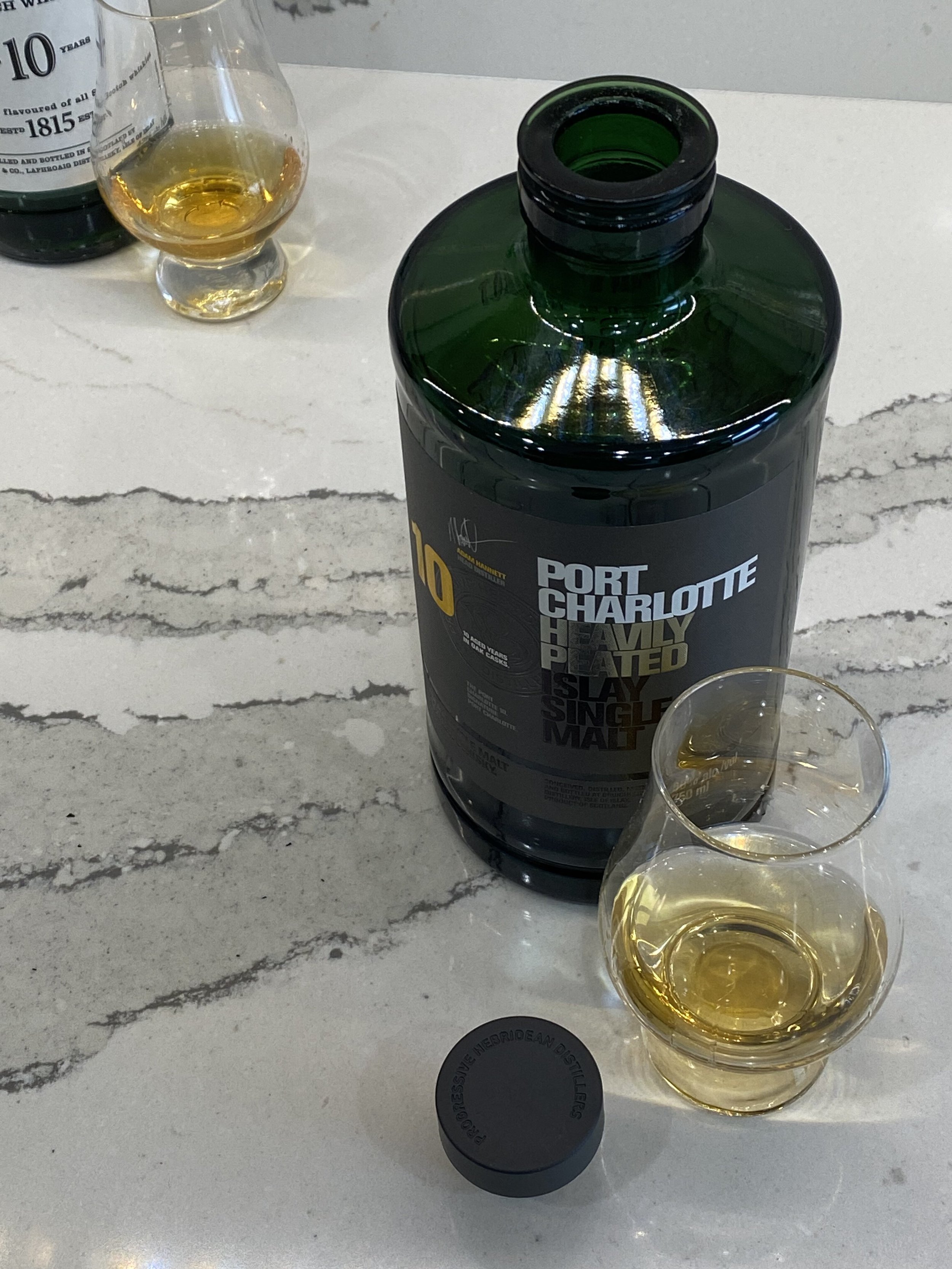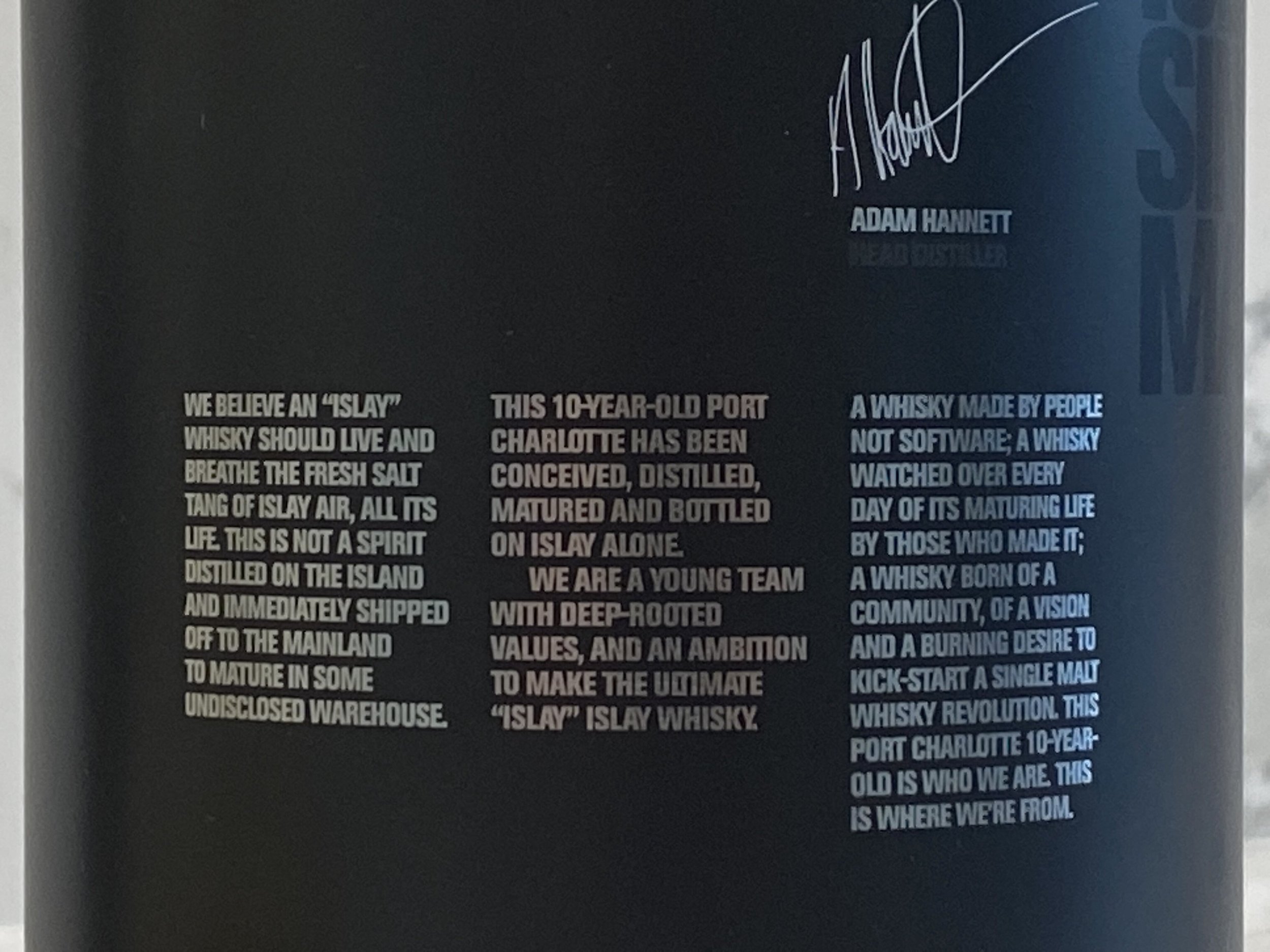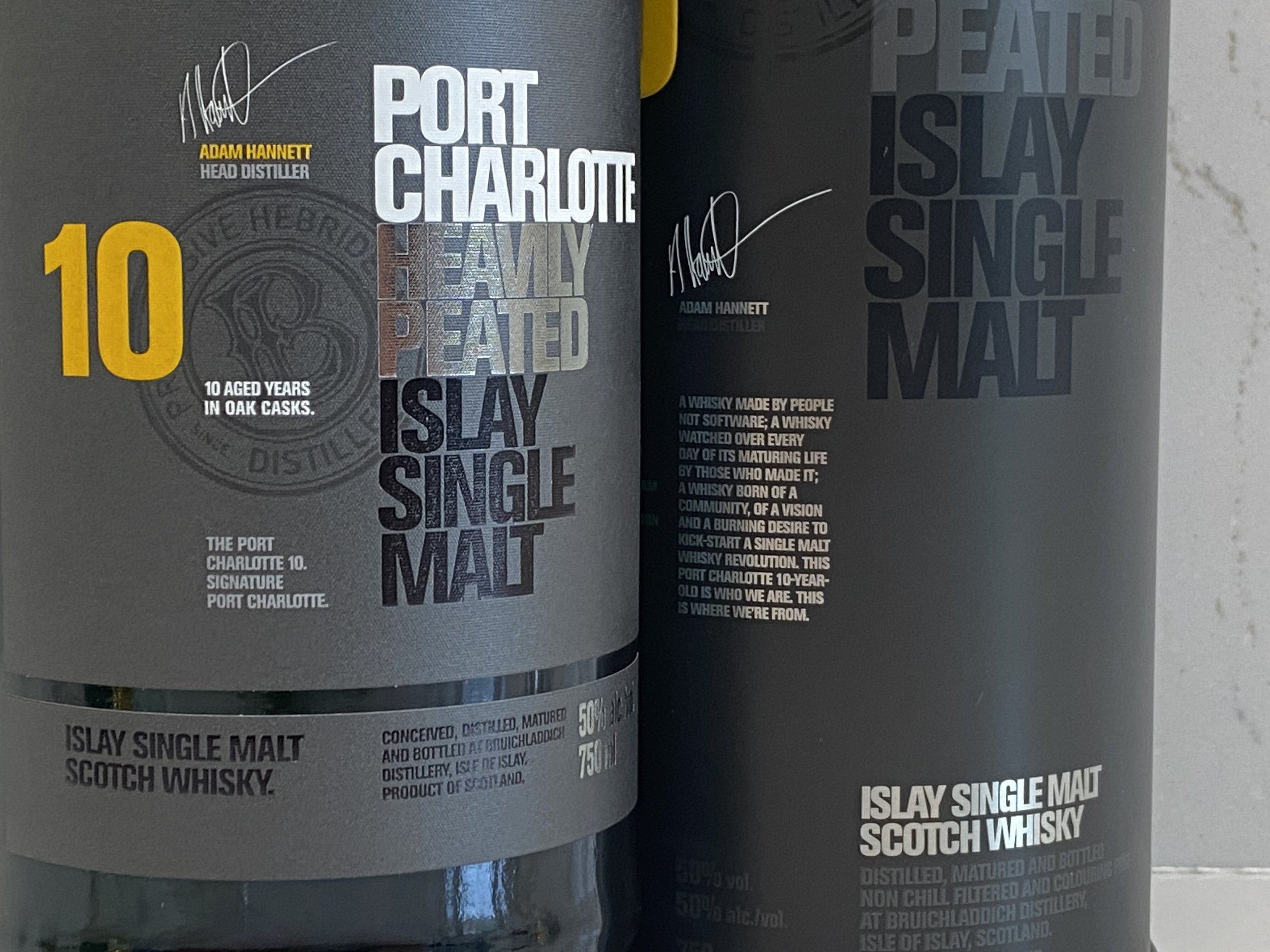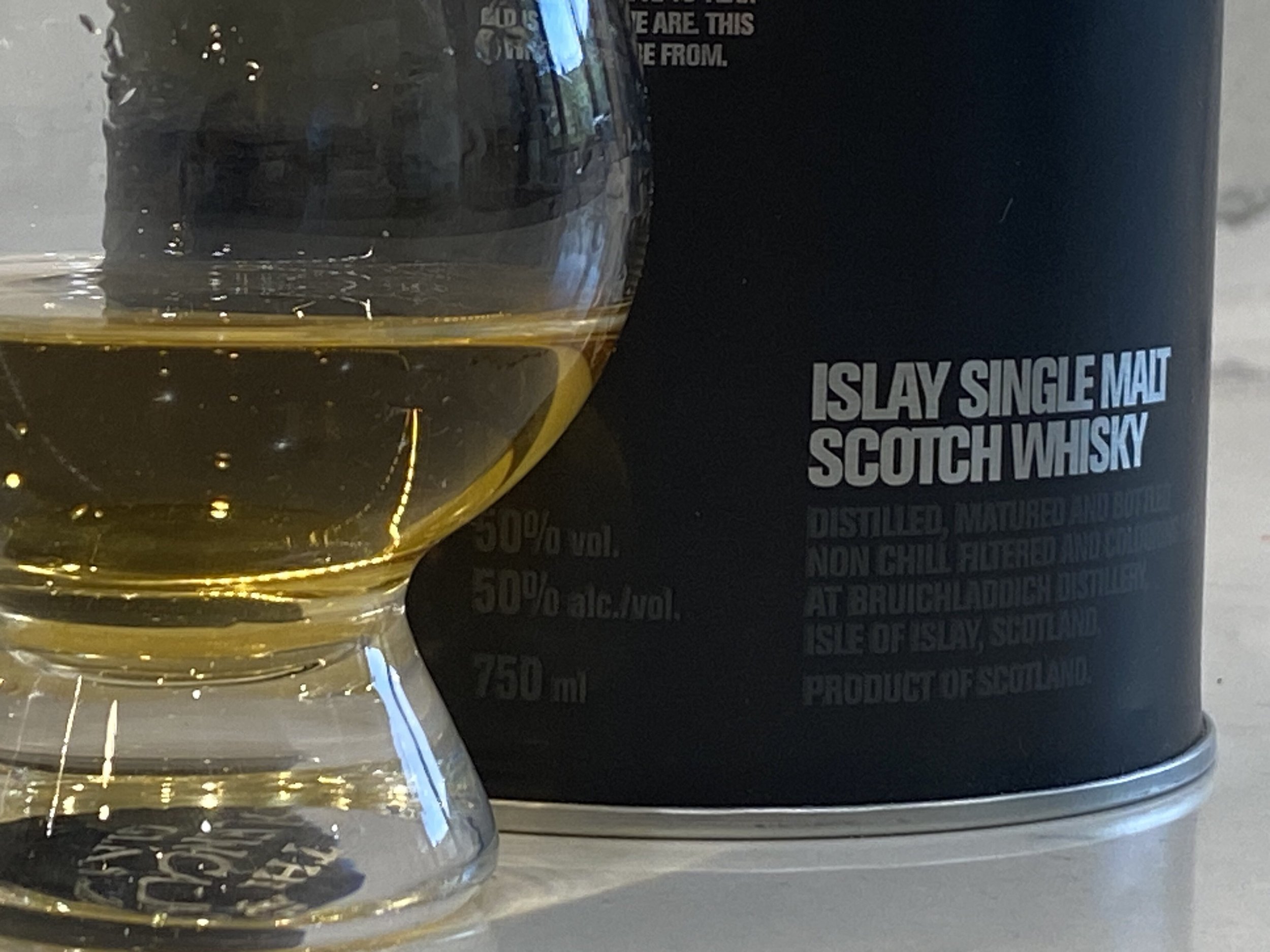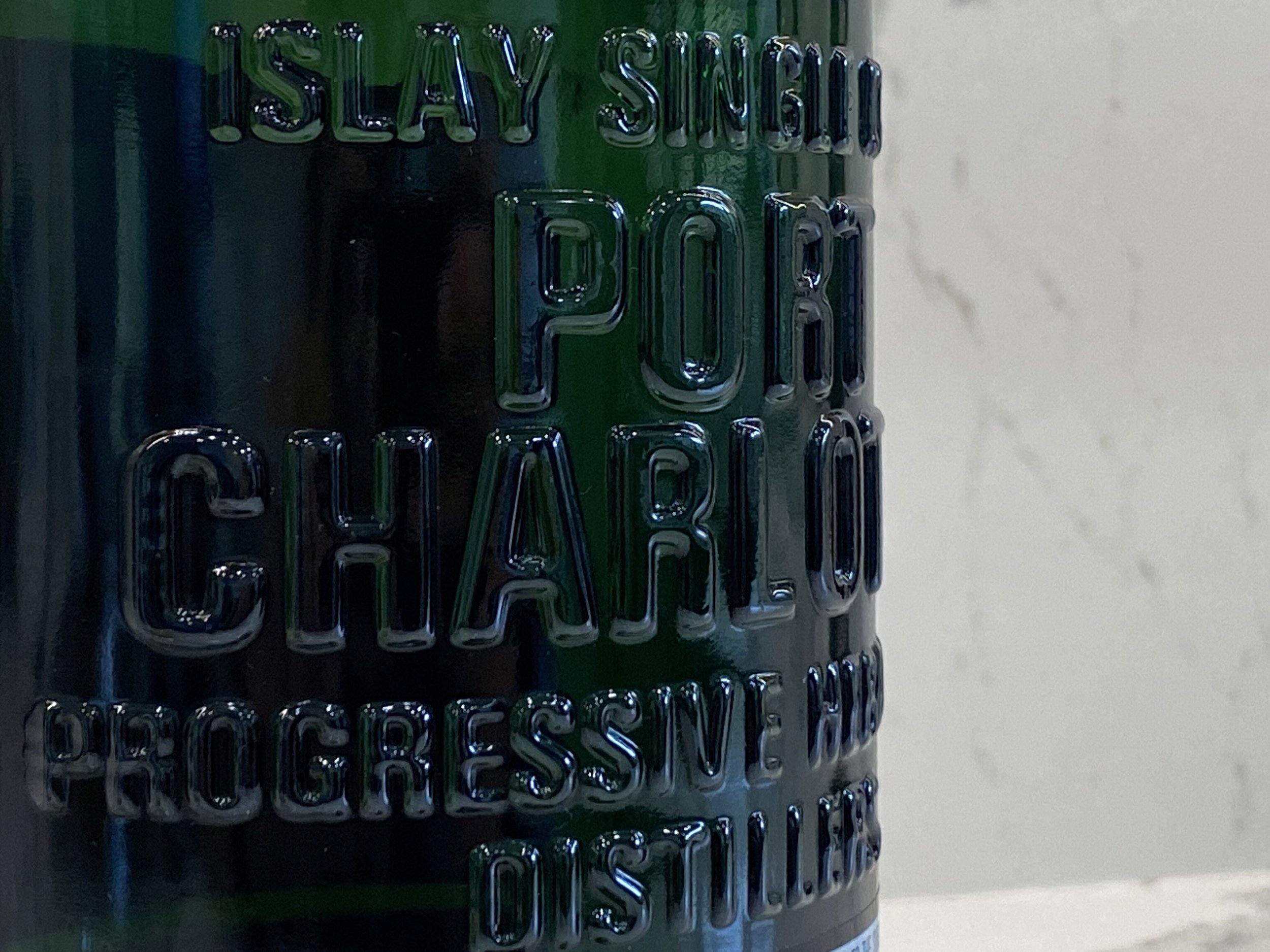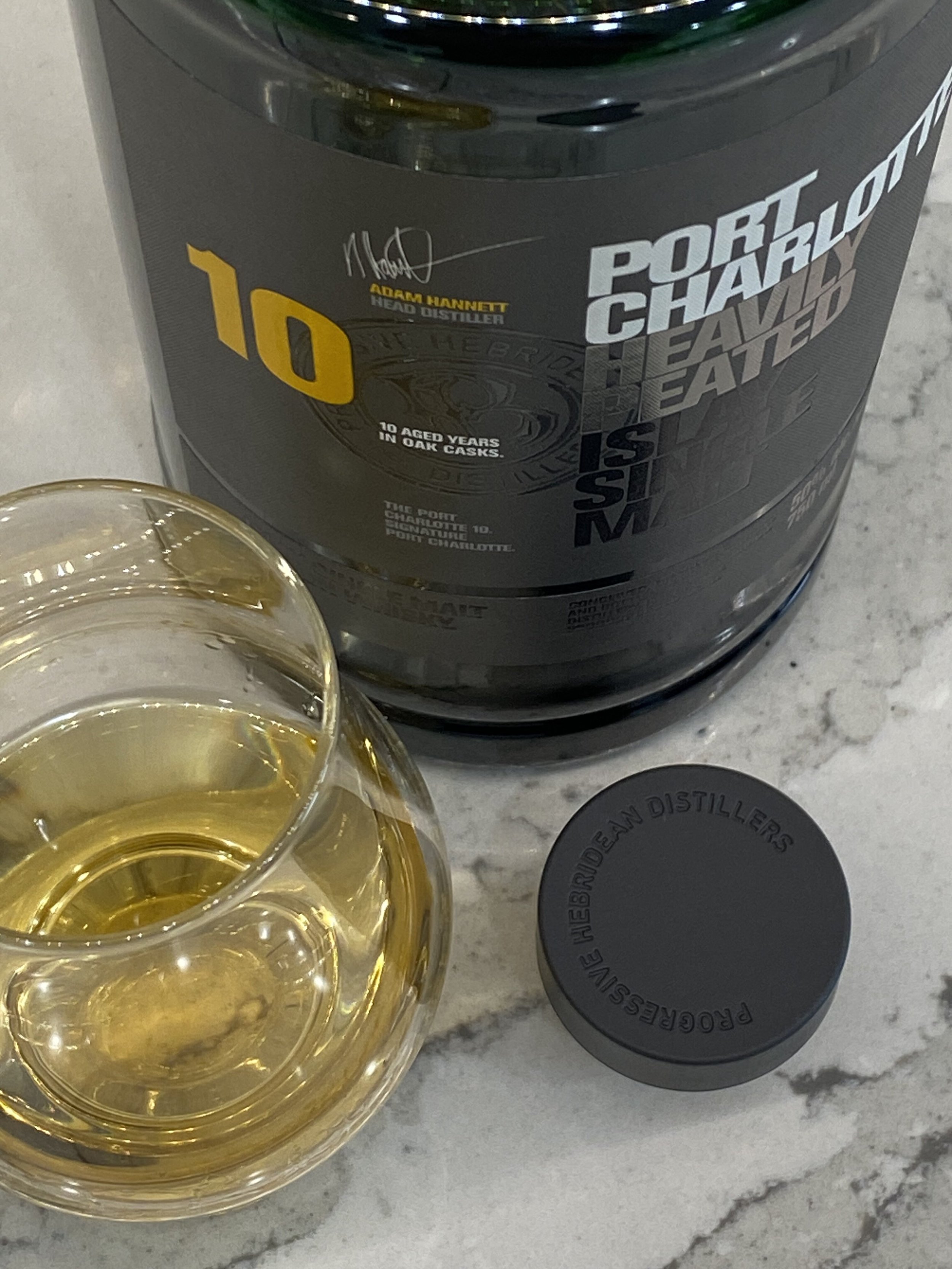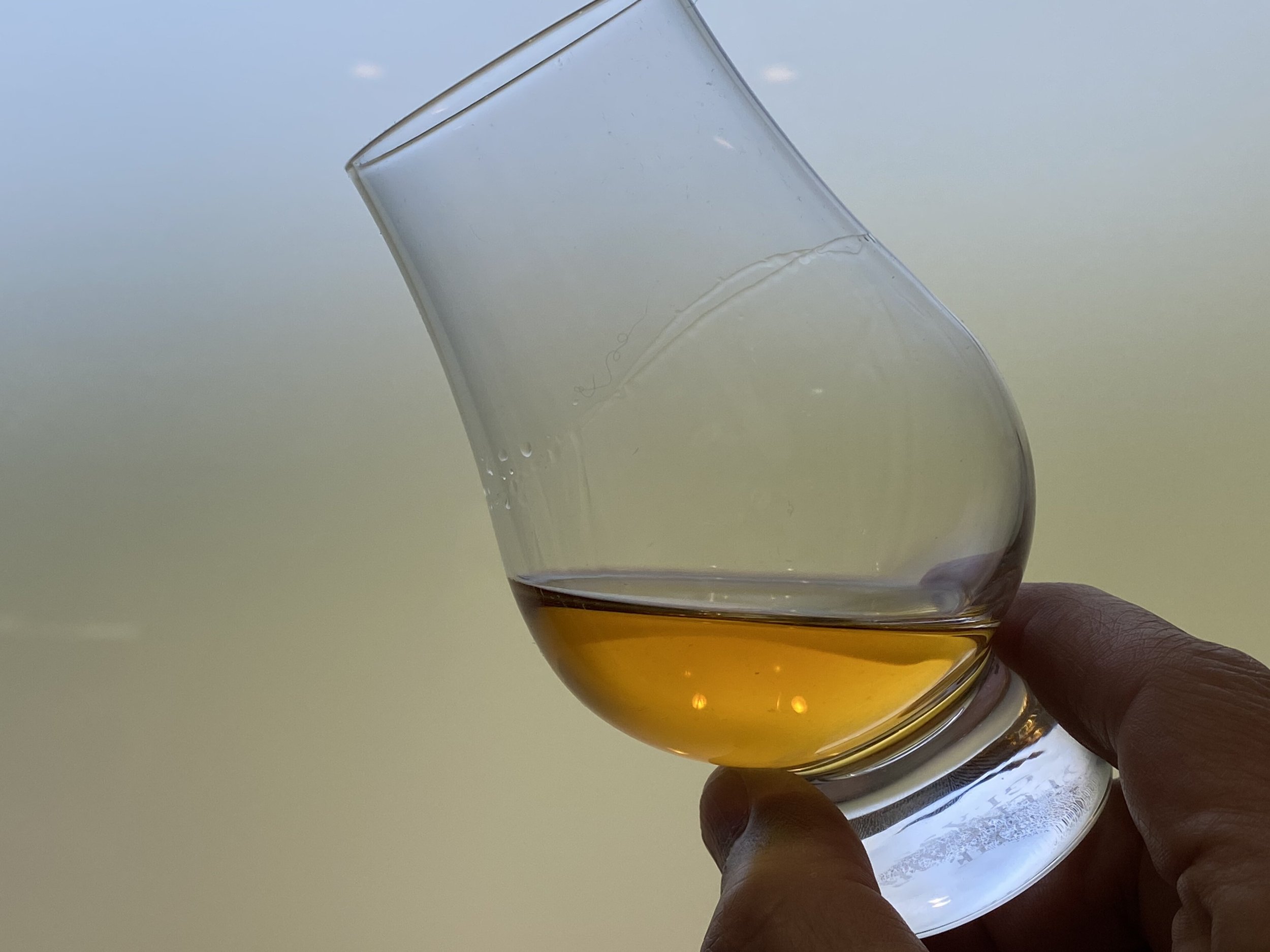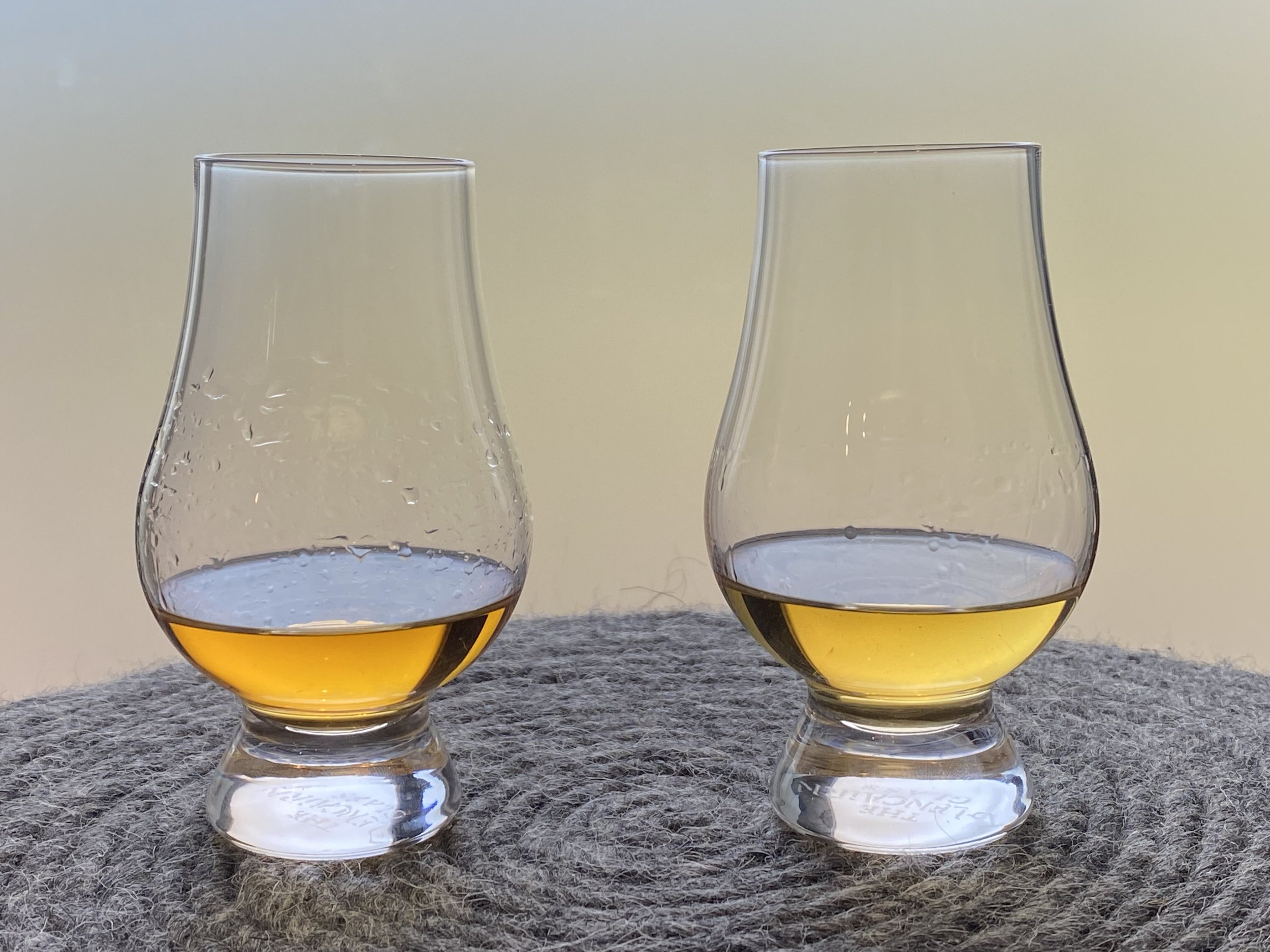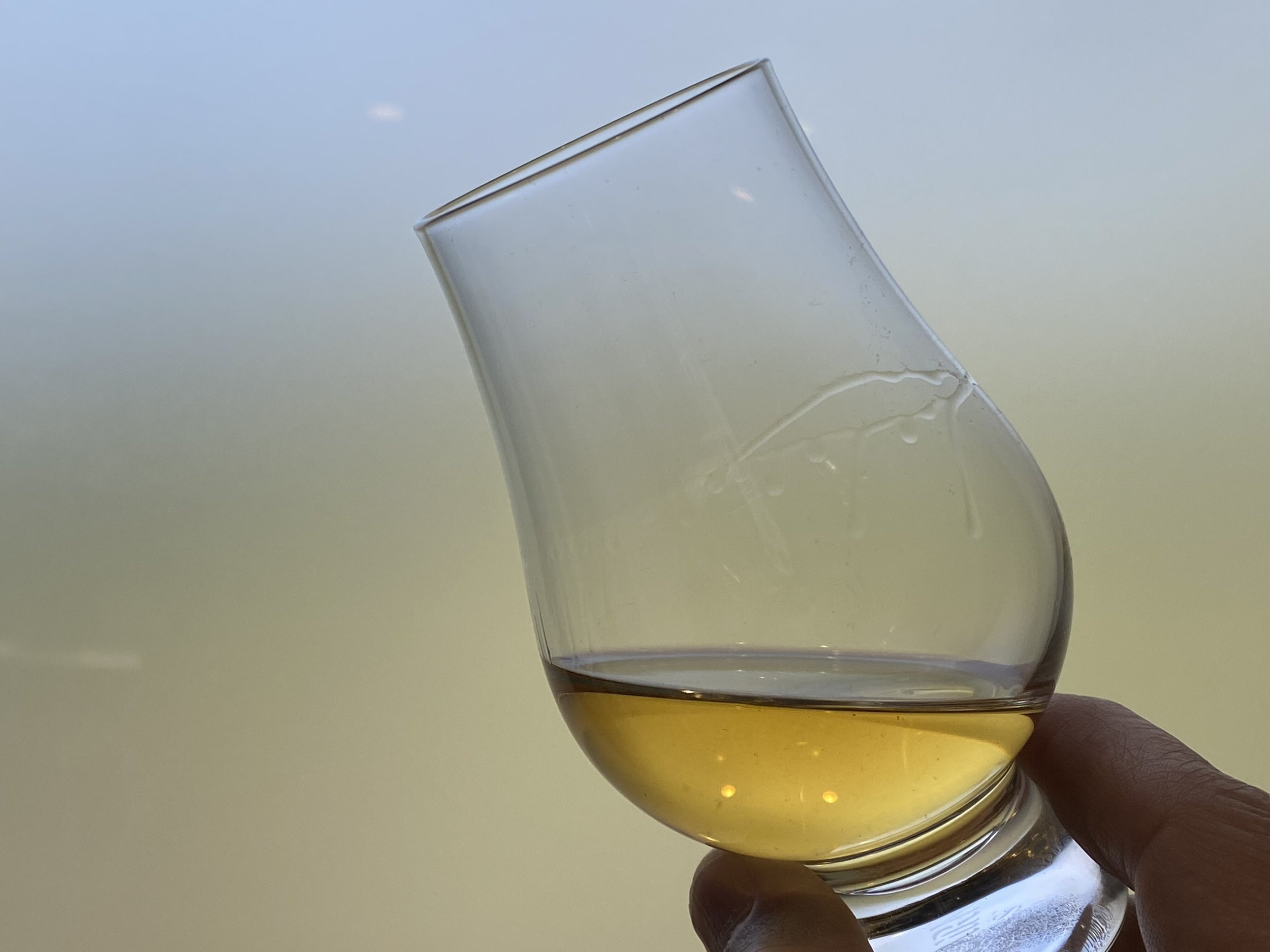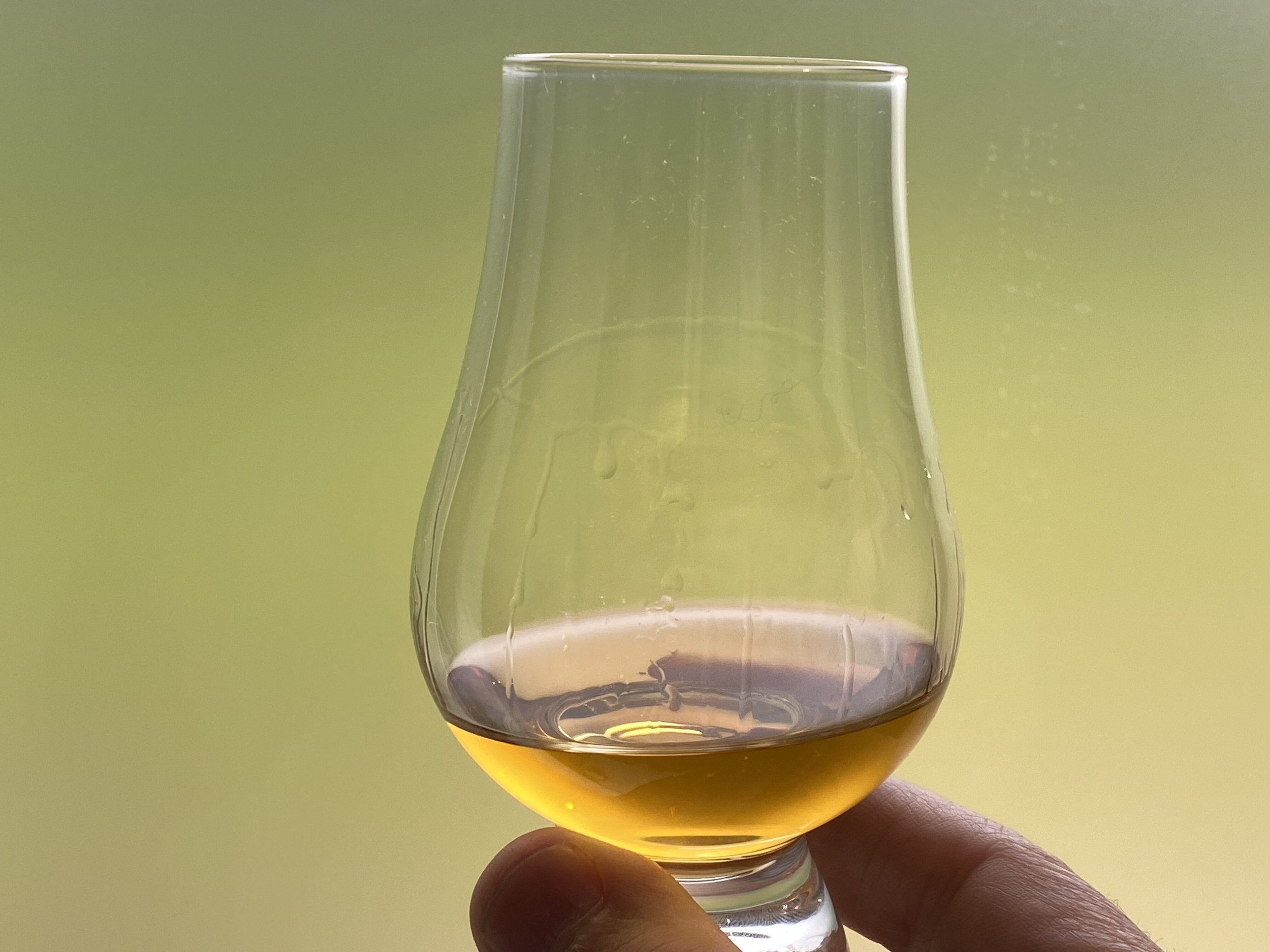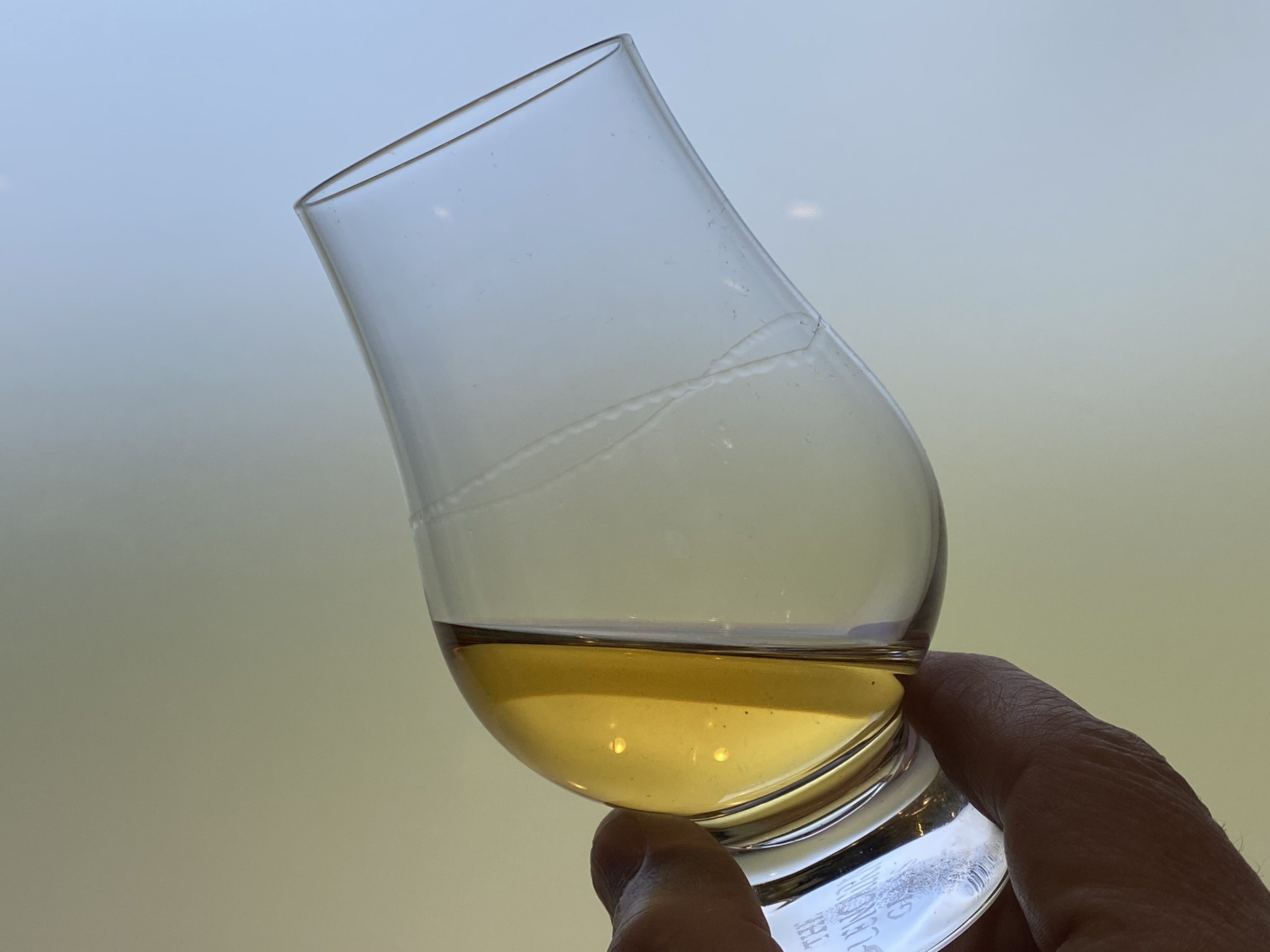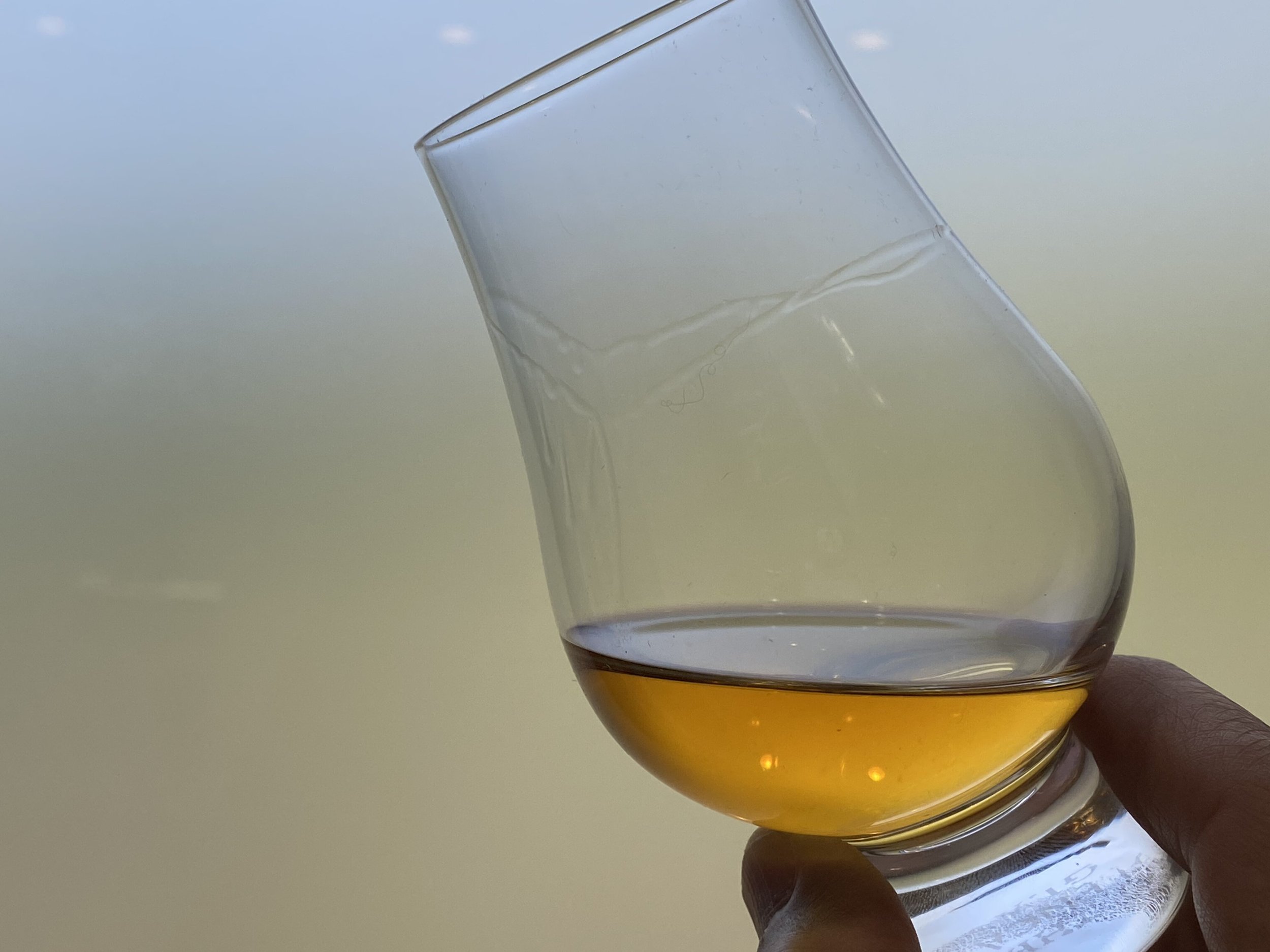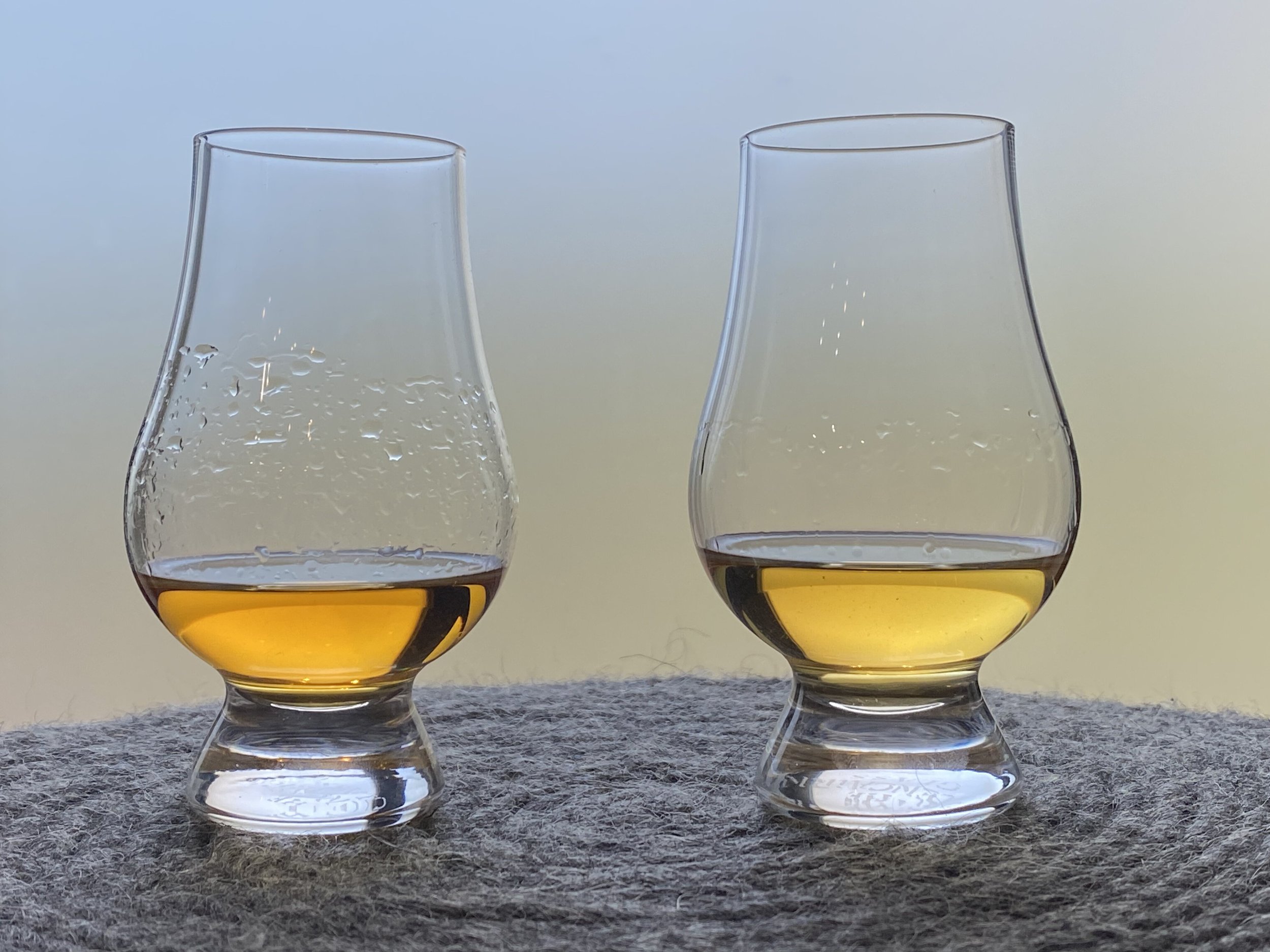Port Charlotte 10 vs Laphroaig 10
Official Bottling Head-to-head | 50% & 40% ABV
Score: 7/10
Very Good Indeed.
TL;DR
Let’s chat this out - it makes a big difference
Authenticity in whisky; the impact of ABV, Chill-Filtration and added colouring
It’s a brisk night in November and I’m celebrating a year of reacquainting myself with Scotch Whisky after a twenty year hiatus of immersing myself in local craft beer culture.
A year ago now, August 2022, I found myself confined in an upstate New York hotel room. Thanks to a precautionary COVID-19 quarantine requirement for my job, I was isolated from the world and solitarily biding my time for seven solid days before getting the “all clear” to continue my journey onward. While the daytime hours were spent on Zoom meetings and tele-working, each night gave me ample time for indulging my interests of history, food, and culture - all thanks to the internet. And DoorDash.
During my quarantine I began to research the next step on my journey, an unusual destination that few people get to experience – the polar frontier of Greenland. Greenland has an interesting history that combines the indigenous Inuit with lingering colonial Danish influences. While those cultures certainly have their interests, I found myself curious to learn more about Greenland’s Viking and Norse historical story.
Along my nightly YouTube explorations, I learned that the same Vikings who explored and settled Greenland were also those who blanketed the rest of the North Atlantic, including Iceland, Svalbard, the Shetlands, and Scotland.
Feeling the isolating effects of my quarantine routine I thought to myself, "Well, if the Scots are descendants of Vikings, and the Vikings are connected to Greenland, and Scotland makes Scotch, then maybe Scotch can reveal something insightful about these ancient Norse peoples." What can I say, I was isolating and it made sense at the time.
To facilitate this admittedly unusual confluence of ideas, I bought a bottle of Arran 10-year-old Single Malt based on some “WhiskyTube” research; shoutouts to Aqvavitae, FirstPhil, Ralfy & GWhisky for the content and solid recommendations. Looking back on it now, had I done just a wee bit more research, I probably would have picked something from northern Scotland, like Highland Park or maybe Old Pulteney. However, as fate would have it, Arran’s 10 yo whisky turned out to be a good choice because it successfully pulled me back into Scotland’s Whisky vortex.
Over the next three weeks in Greenland, I fully immersed myself into learning about the historic Viking settlements of the North Atlantic, complemented by a nightly dram of Arran’s malty, floral spirit. It made for a great way to while away the autumnal days of Greenland.
When I returned home, I dug out two old bottles gathering dust in my basement: they turned out to be Ardbeg’s Uigeadail and Highland Park’s 18 year old. Suffice to say, each of those two bottles further opened my eyes to what the range of what “Scotch” could be and I quickly became hooked.
Fast forward to today and I’m back home in Colorado with a year’s worth of whisky exploration behind me. It’s been a fun year full of continuing this rediscovery and sharing it with my friends and family. Along the way, I’ve picked up the hard-to-miss messages by the Whisky Enthusiast community: that not all Scotch Whiskies are made the same thanks to "The Big Three:” Chill Filtering, Added Colouring, and ABV. Once I caught on to this message, it became easy to spot the distilleries who are committed to making a more authentic whisky from those that don't. All of this makes sense to me in an academic way, but I wondered if these differences are noticeable to a whisky-noob like me?
Which brings me to my comparative review of two similar whiskies: Laphroaig 10 and Port Charlotte 10. I realise that for many Dramface readers, this comparison has already been settled. As such, I’m not writing this to pit one brand against the other in a head-to-head, Winners vs. Losers showdown. Both whisky brands carry legacies written in centuries and both have huge numbers of committed devotees who will swear by their favourite malt. But for me, I believe there are few better whiskies that can be used to discover if chill-filtration, added coloration, and a difference in ABV are enough to expose the recognizability of these production differences.
In preparation for my exploration into these two whiskies, I decided to do some homework and see if their backgrounds will help illuminate the commonalities and distinctions between these two smoky drams. Along the way I came across a few interesting bits that felt worthy to share. So, with all of that out of the way, let’s introduce our two contenders.
Starting off with a quick review of our two distilleries:
Both Bruichladdich (makers of Port Charlotte) and Laphroaig are geographically located on the same island of Islay in Scotland.
Both distilleries are well known to leverage the regional character of Islay for its windswept, rugged climate, salty air, and rich soils.
Both were founded in the 1800’s but have grown today to become dominant players in Scotland’s growing Single Malt Whisky scene. Today, each measures their total annual production in terms of millions of Litres.
Moving beyond the macro scale, the two individual whiskies themselves also share a few commonalities:
This is stating the obvious, but both are aged for at least 10 years in oak and represent their “Core Range” and primary expression.
Each of these whiskies are matured in ex-bourbon casks for at least a portion of their life.
Both are known to be “Heavily Peated” whiskies with flavour profiles that are often described as being smoky, rich, and characterful.
Both use barley gown on the island of Islay, though only a portion of their totals.
Both distil their wash for 72 hours.
Alright, so for those of you who are more familiar with these two whiskies, you may notice how I’m choosing my words above. You may be able to see through what I’m choosing to omit, what I’m choosing to include, and how I’m measuring them against each other. This is because within these similarities there are important “sub-differences” that when tallied up, will hopefully help uncover how two similar whiskies can end up revealing noticeable differences from each other.
So let's talk about these differences. First, our distilleries:
While each was founded in the 1800’s, they individually capitalise on that history in vastly different ways. Laphroaig was founded in 1815 when illicit distilling was still the predominant means for whisky production in Scotland. As such, the original Johnston brothers had to resort to sourcing materials in hidden areas on Islay so that they could hide production of their illegal spirit from the excise-man. Among those locally sourced materials was the peat used to dry their malted barley.
Today, Laphroaig still uses the same peat from these original locations on Islay, and it is that unique Islay peat that is often cited for giving their 10 year old its characteristic medicinal quality – often described as tasting of Band-Aids, iodine, and cold-smoke. The origin of that unusual “Islay” flavour comes from the influence of decayed sphagnum mosses, seaweed and heather. Sphagnum moss in particular has antiseptic qualities that help to give it that medicinal flavouring. The decayed seaweed helps add to that coastal, briny flavouring some find in this ten year old.
Bruichladdich, by comparison, was built in 1881 well after Scotland passed both the Illicit Distillation Act of 1822 and the Excise Act of 1823 which, taken together, brought whisky-making out of the shadows. This difference of some 70 years meant that Bruichladdich could set up their distillery out in the open without any of the baggage that came from illicit production. Taking advantage of this legal licence, the original Harvey brothers took their experience from building two previous distilleries in Glasgow to open Bruichladdich with a more commercial or industrialised approach to business.
There, much like Bunnahabhain on Islay’s north east cost in the same year, they leveraged state-of-the-art Victorian era engineering and large, flat-bottomed boats to bring in larger quantities of fuel and resources from elsewhere in Scotland. This approach continues to leave its imprint on their production today, where Bruichladdich sources some of its mash ingredients locally while their peat comes from the Scottish mainland. As such, their peated whiskies did not carry the same peat smoke or medicinal intensity as the Laphroaig.
I speak of Bruichladdich because it’s this distillery that revived the brand after the original Port Charlotte/Lochindaal distillery was closed in 1929. With some of the buildings still intact and in use, there were plans - now abandoned - to revive the Port Charlotte distillery. However, in 2006 Bruichladdich used the branding for its heavily peated style as a nod to that which may once have been made two miles south. The modern Port Charlotte is better known for aromas and flavours that evoke candied bacon or mesquite BBQ smoke.
So, while Laphroaig and Bruichladdich are located on the Isle of Islay, they are not next-door neighbours. The distance between them is about 18 miles and they are situated on different parts of the island. The weather on the west half of Islay, where Bruichladdich is, is often sunnier than that of the eastern part of the island, where Laphroaig is. These small geographical variations can bring about microclimate influences that could possibly contribute to some hyper-localised character to the spirits. Maybe.
When it comes to production and distillation, both Bruichladdich and Laphroaig are known for using tall stills – however there are differences between them. Laphroaig’s stills have an upward sloping Lyne arm attached. Lyne arms that are angled upwards create more reflux during distillation, meaning that many of the heavier spirit vapours and oils that condense on the inside surface of the Lyne pipe will trickle back down back into the body of the still and be re-distilled again and again until broken down into an ever-lighter spirit. This higher amount of re-distillation or reflux results in a lighter new make spirit that’s commonly viewed as cleaner with less of the heavier mouthfeel of oilier whiskies.
Bruichladdich, by contrast, uses stills that have downward sloping Lyne arms attached to them. These downward sloped Lyne arms discourage reflux, effectively preventing re-distillation of the heavier, oilier compounds and allowing them to survive intact where they are captured downstream in the condenser. The result is a heavier new make spirit that’s “dirtier” and perhaps more complex.
So far all these differences contribute to what some call a Distillery’s “House Style.” But now it’s time to discover if these subtle differences are recognizably different to me, after maturation, vatting and bottling. And more so, does a whisky’s “integrity presentation” through Alcohol by Volume (ABV), chill filtering, and colouration really communicate quality or desirability in a way that’s recognisable.
Laphroaig bottles their 10 year old at a rather dilute 40% (or 43% ABV depending on market, and as reviewed here) or the very minimum required by the Scotch Whisky Association (SWA). Bruichladdich bottles their PC10 at a more robust 50% - the standard for most any Bruichladdich. ABV ultimately measures the amount of ethanol within the spirit and since it’s the ethanol that does most of the heavy lifting when it comes to delivering flavour and aroma to a whisky – I expect to notice some differences here.
Laphroaig bottles their 10 year old with colour added whereas Bruichladdich bottles their Port Charlotte 10 without any additional colour. The colourant that’s commonly used for whisky production is something called E150a, otherwise known as Spirit Caramel, and is technically a food grade colouring additive. E150a is not supposed to impart any flavour so it should not be recognisable to the nose or taste. This might be harder for a noobie like me to ascertain. We’ll see.
As a side note; I’m intrigued by the opinion of Brown Forman’s Master Blender (for their scotch portfolio) Dr Rachel Barrie, who apparently abhors the use of caramel colouring in scotch whisky and even shares her relief at moving to an organisation in 2017 that chooses not to use it in their malts at all. Very revealing. You can hear more in the Not Another Whisky Podcast session with her here.
Lastly, Chill-Filtration. The process by which a distillery can choose to strip out fatty acids, proteins, and other long-chain esters. Laphroaig filters their 10 year old, whereas Bruichladdich does not. Why is chill filtration a thing? For aesthetics it seems.
Under certain conditions, these acids, proteins, and esters can cause cloudiness when the whisky is cooled down enough – usually by the addition of some ice or cold water in the glass or sometimes transportation and storage. It's often argued that filtering out these compounds will have a noticeable impact to a whisky’s flavour and texture – giving it a thinner mouthfeel. Again, this might be harder for a noobie like me to notice, but a thicker, more viscous whisky sounds more appealing to me than a thin, watery one.
Now onto the testing. Rather than running through a straightforward tasting of the two drams side by side, I figured a couple of blind comparisons should help me understand the merits of these two whiskies as well as where I’m at in my whisky journey. I decided to go with two three-way blind tastings with the introduction of an interloper designed to “throw me off the scent” and introduce some unpredictability. I elected to include Kirkland’s Islay Single Malt to play the part of interloper. This was for a couple reasons: it has an ABV in the middle between our two contestants, it’s another “heavily peated” whisky, and lastly, it’s also from Islay.
Tasting notes were recorded and mated to numbered glasses. I’ll save the Kirkland notes for another review since it is only here for control purposes.
Review 1/2
Laphroaig 10yo, Official bottling, 43% ABV
c.£40 US$39.99 paid and ubiquitous
Laphroaig’s standard 10 year old is a mixed bag. On one hand, you get a rich, characterful experience delivered from a distillery that has a historic pedigree. On the other hand, it’s an experience that’s cut short in some ways and artificially enhanced in others. Like many, the first time I ever tried Laphroaig I couldn't get past the immediate sensory surprise of medical grade iodine. Today, however, the Laphroaig 10 is completely enjoyable for me. It feels like an achievement unlocked, like I’ve levelled up in my whisky journey.
Despite the two blind comparisons, I was able to correctly identify all three drams after a couple of passes under the nose. The Kirkland had a distinctive custard aroma that sets it apart (Caol Ila?). From there it wasn’t too hard to identify the Iodine of the Laphroaig which left the PC10. Once I had nailed them down I had my friend remove the foil wraps as I wanted to see their colour.
Score: 5/10
Average. In a good way.
TL;DR
Seaweed smoke and candied bandages
Nose
Rich peat smoke. Funky, burnt caramel. Iodine medicine. Sea salt. Something like sea smoke comes to mind – like a campfire made of damp driftwood collected on a saltwater beach. More nosing brings back more medicinal notes, however, at this time in my whisky journey, that characteristic is less dominating than when I was much younger. If I pay attention beyond those initial elements, there’s a mineralic quality that’s overlayed or braided with the smell of sweet cookies.
This 10yo dram can have me nosing it for hours – it's just interesting. When presented to me blind, I was able to identify it fairly quickly as the medicinal notes stand out – even against the other peated Islays.
Palate
For me, this opens with Iodine and it's quickly followed up with rich, funky, aromatic smoke. Black pepper lingers for a bit before fading away to a thinning sensation. There are vegetal notes tucked in there like fresh cut spearmint. Actually, it's more like a mix between spearmint and a less sweetened version of peppermint. On some sips there are notes of sweet black liquorice – which in real life, liquorice candies are terribly unpleasant for me... but here, in this dram, it adds an enjoyable and beneficial dimension. Along the backbone of the dram is an element of bourbon-y sweetness. That sweetness is not immediately part of the foreground but isn’t too far off.
The finish is over too quickly and there’s nothing left to savour once it's washed away.
The Dregs
I count myself as a Laphroaig convert. I love the challenge it presents; I love the uniqueness of character this whisky brings to the experience. It’s not a simple dram for me and it's one that begs for attention while you’re drinking it. When I factor in the value proposition, the Laphroaig 10 is really hard for me to beat. I had my eye on a bottle for a few months, waiting for it to dip down to somewhere around $40 USD. When I found it for $41 I pounced and counted myself lucky. I gleefully ran back home and registered for my square foot which I someday hope to visit. The world is better for having Laphroaig. It punctuates the scotch whisky flavour spectrum and highlights what peat can be. I also feel like it underscores what Islay Whisky “is.”
The problem I have with Laphroaig 10 is that it's over much too quickly. Which is too bad, because it’s a wonderful whisky that disappears about as fast as it shows up. The fuller, more authentic, Laphroaig 10 experience requires me to buy their Cask Strength edition which ends up being about twice the price of this one at about $95 USD.
It's hard for me to judge the Laphroaig 10 too harshly for being watered down, filtered, and coloured. It’s a popular whisky that’s sold all over the world at a compelling value-tier price. I understand that Beam Suntory chooses to face the logistical challenges of worldly distribution by standardising their product to ensure consistency. I get it – batch variation seems to be something they cannot tolerate. I’m not quick to judge Laphroaig.
That is until I compared it against Bruichladdich’s Port Charlotte 10.
Score: 5/10 EMc
Review 2/2
Port Charlotte 10yo, Non-chill filtered, Natural colour, 50% ABV
c.£55 US$69.99 paid and also widely available
If you can give up the iodine for something more densely herbal and malty; there’s so much to explore here. For how ‘similar’ these two neighbouring drams actually are, they could not be more different.
Bruichladdich’s Port Charlotte 10 sits on the value spectrum at an interesting spot. Being 50% ABV, it straddles the midway point between Laphroaig's standard 10 and their Cask Strength. Similarly, so does the price point with the standard PC10 priced in my market at around $70 USD. For the money you get a naturally presented whisky, with no added colouring, non-chill filtered, and nearly cask strength ABV.
Score: 7/10
Very good indeed.
TL;DR
Less iodine, but more of everything else
Nose
Salty, smoked bacon. Campfire smoke. There are malty sweet and floral aromas that this heavily peated whisky shares with other, unpeated Bruichladdich whiskies. To test that theory, I broke out a bottle of Bruichladdich's 2011 Islay Barley expression and could quickly pick up on some of those familial commonalities between them.
Everything is “richer” for me with the PC10. The aromas of candied (but not overly sweet) bacon, black pepper, and salty meats are delivered with each inhale – there’s more volume and depth than with the Laphroaig.
Palate
The peat smoke is real. What it lacks in iodine shock and awe, it delivers in density and intensity. When Bruichladdich says this is a “Heavily Peated Islay Single Malt” they’re not making an overstatement. The word, ‘rich’ again comes to mind and I think it stems from the malty sweetness anchoring the other flavours.
Wrapped up in all that peat-smoke are black peppercorns and fresh jalapeno peppers. When the PC10 first hits my tongue, there's a distinct cooling effect – like a minty sensation without the flavour of mint. Once it stays on the palate for a moment that minty cooling transitions to spicy heat as it warms up.
In stark contrast to the Laphroaig 10, the viscosity of the PC10 feels thicker. My gums numb a bit, and multiple aspects of the flavour remain for minutes after washing it back. The oiler mouthfeel, especially when compared with the Laphroaig, is so distinctly noticeable. It’s a genuinely significant difference.
Where does that mouthfeel and flavour difference come from? Well, it's likely from a couple of factors: the PC10’s higher ABV and the lack of chill-filtration. To discover the impacts of these two causes led me to a conversation with Tyree - one of the resident Dramface super-geeks. Here's what I learned from him:
“One familiar message is that there’s not much data in the way of quantifying the sensory impact of chill-filtration, including mouthfeel. We know that the purpose of the filtration is to remove compounds which cloud a liquid when cooled (called Flocculation), but these compounds are also known to contribute to a whisky’s mouthfeel. Ultimately, while it’s a reasonable assumption to make that chill-filtration has impacts on the way a whisky feels, the research is just inconclusive at this time.”
This part of the conversation I was prepared for, what came next surprised me.
“The casks used to mature these two whiskies also likely contribute some subtle differences to mouthfeel. Where the Laphroaig is aged mostly from ex-bourbon (American Oak) casks, the PC10 uses both American Oak and European Oak, via some reused ex-French wine casks. French oak is higher in condensed tannins and has bigger pores within the woodgrain. The result means that the PC10 will have a greater accumulation of condensed tannins than Laphroaig’s 10yo. This is important because condensed tannins are prone to bonding with the proteinaceous components of saliva. Thanks to some more chemistry, these tannins contribute to a whisky’s “grip,” similar to the experience one has from drinking red wine or strong teas, for instance.
Thirdly, there is still the impact that ABV can have on mouthfeel. This is likely where most of the difference in mouthfeel between the two whiskies lies. The Laphroaig’s 40/43% (depending on market) and the Port Charlotte’s 50% ABV more directly affects their texture.” More ABV means more ethanol, more ethanol means more congeners, and more congeners means more flavour.
The Dregs
When I reflect on my original concept for this article – assessing where I’m at in my whisky journey by navigating through what, if any, the impacts of chill-filtration, ABV, and colouring I’m able to ascertain; I find myself with mixed results.
Researching the distilleries taught me a lot of valuable context; like how a distillery’s story can be more than just the marketing department’s talking points. Rather, sometimes, these esoteric, historical elements create little consequences that cascade through time... little choices, made centuries ago, that give character and uniqueness to a distillery. As I tasted my way through these two whiskies, I would at times, reflect on these unique histories as it gave me a way to connect to them.
In contrast, however, there are some characteristics that are intentional and by design. For example, the addition of food grade colourant to disguise a whisky’s real colour. Broadly speaking, this is a put-off for me. I’m far more interested in seeing the true colour of a whisky to reveal how much the wood, sherry, bourbon, or whatever has influenced the spirit.
I remember seeing some Johnnie Walkers in my past that had the look of a ‘Technicolor’ orange to them... overemphasised or overcompensating? Maybe. The Laphroaig’s colouration is subtle in comparison to Johnnie Walker, though still noticeable when sitting right beside the PC10. Seems to me that Beam Suntory could ditch Laphroaig’s E150a and save the company a few thousand dollars in production costs(?).
So this leaves me with the finish or mouthfeel. Where the Laphroaig's finish is short lived, the PC10 lingers well beyond the initial splash. Here’s my take; if taken separately, it’s hard for me to notice Laphroaig's short finish. But taken together, side by side, the difference is stark. Maybe this is what Beam Suntory is banking on; that average whisky drinkers are not actively comparing products side by side – analysing their subtleties, contrasting their differences. But whisky enthusiasts will, most certainly, do exactly that; seek out and discover rather quickly that the Laphroaig 10yo comes away lacking.
At the end of it all, what I can say with 100% certainty is how much ABV, chill-filtration and food die means to me in my whisky purchase. Product authenticity, regardless of my ability to ascertain it myself, is fundamentally important to me. I want to know that the whisky in the glass represents the most authentic expression of the distillery’s skill and creativity. I want to learn about and understand the whisky’s characteristics, strengths, weaknesses, history, and provenance. Otherwise, what’s the point?
I’d like to acknowledge the research help I received from both Tyree and Wally for this article.
Score: 7/10
Tried this? Share your thoughts in the comments below. EMc
This article is a Friday First
Our resident socials handler and general positive spirit is Eallair, and he’s a dedicated reader of all things Dramface. This is his first article submission. We put it out to you for your feedback and input. We think it’s an absolute banger - but he’ll only be welcomed back if you folks like it too. Share your thoughts in the comments!
-
Dramface is free.
Its fierce independence and community-focused content is funded by that same community. We don’t do ads, sponsorships or paid-for content. If you like what we do you can support us by becoming a Dramface member for the price of a magazine.
However, if you’ve found a particular article valuable, you also have the option to make a direct donation to the writer, here: buy me a dram - you’d make their day. Thank you.
For more on Dramface and our funding read our about page here.
Other opinions on this:
Laphroaig 10yo
Port Charlotte 10yo
Not Another Whisky Podcast with Rachel Barrie
Got a link to a reliable review? Tell us.

